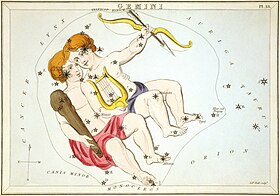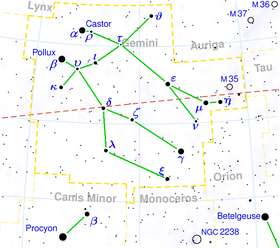Thành viên:CrossEF/nháp2
Mythology[sửa | sửa mã nguồn]


In Babylonian astronomy, the stars Castor and Pollux were known as the Great Twins. The Twins were regarded as minor gods and were called Meshlamtaea and Lugalirra, meaning respectively 'The One who has arisen from the Underworld' and the 'Mighty King'. Both names can be understood as titles of Nergal, the major Babylonian god of plague and pestilence, who was king of the Underworld.[1]
In Greek mythology, Gemini was associated with the myth of Castor and Pollux, the children of Leda and Argonauts both. Pollux was the son of Zeus, who seduced Leda, while Castor was the son of Tyndareus, king of Sparta and Leda's husband. Castor and Pollux were also mythologically associated with St. Elmo's fire in their role as the protectors of sailors.[2] When Castor died, because he was mortal, Pollux begged his father Zeus to give Castor immortality, and he did, by uniting them together in the heavens.
Visualizations[sửa | sửa mã nguồn]

Gemini is dominated by Castor and Pollux, two bright stars that appear relatively very closely together forming an o shape, encouraging the mythological link between the constellation and twinship. The twin above and to the right (as seen from the Northern Hemisphere) is Castor, whose brightest star is α Gem; it is a second-magnitude star and represents Castor's head. The twin below and to the left is Pollux, whose brightest star is β Gem (more commonly called Pollux); it is of the first magnitude and represents Pollux's head. Furthermore, the other stars can be visualized as two parallel lines descending from the two main stars, making it look like two figures.
H. A. Rey has suggested an alternative to the traditional visualization that connected the stars of Gemini to show twins holding hands. Pollux's torso is represented by the star υ Gem, Pollux's right hand by ι Gem, Pollux's left hand by κ Gem; all three of these stars are of the fourth magnitude. Pollux's pelvis is represented by the star δ Gem, Pollux's right knee by ζ Gem, Pollux's right foot by γ Gem, Pollux's left knee by λ Gem, and Pollux's left foot by ξ Gem. γ Gem is of the second magnitude, while δ and ξ Gem are of the third magnitude. Castor's torso is represented by the star τ Gem, Castor's left hand by ι Gem (which he shares with Pollux), Castor's right hand by θ Gem; all three of these stars are of the fourth magnitude. Castor's pelvis is represented by the star ε Gem, Castor's left foot by ν Gem, and Castor's right foot by μ Gem and η Gem; ε, μ, and η Gem are of the third magnitude. The brightest star in this constellation is Pollux.
In the history of astronomy[sửa | sửa mã nguồn]
In Meteorologica (1 343b30) Aristotle mentions that he observed Jupiter in conjunction with and then occulting a star in Gemini. This is the earliest-known observation of this nature.[3] A study published in 1990 suggests the star involved was 1 Geminorum and the event took place on 5 December 337 BC.[4]
When William Herschel discovered Uranus on 13 March 1781 it was located near η Gem.[5] In 1930 Clyde Tombaugh exposed a series of photographic plates centred on δ Gem and discovered Pluto.[6]
Equivalents[sửa | sửa mã nguồn]
In Chinese astronomy, the stars that correspond to Gemini are located in two areas: the White Tiger of the West (西方白虎, Xī Fāng Bái Hǔ) and the Vermillion Bird of the South (南方朱雀, Nán Fāng Zhū Què).
Astrology[sửa | sửa mã nguồn]
Tính đến năm 2011[cập nhật], the Sun appears in the constellation Gemini from June 21 to July 20. In tropical astrology, the Sun is considered to be in the sign Gemini from May 22 to June 21, and in sidereal astrology, from June 16 to July 16.[7]
Tham khảo[sửa | sửa mã nguồn]
- ^ Babylonian Star-lore by Gavin White, Solaria Pubs, 2008, page 125
- ^ Ridpath & Tirion 2001, tr. 150-152.
- ^ Star Names: Their Lore and Meaning by Richard Hinckley Allen, Dover, 1963, page 229
- ^ Cohen, Sheldon M.; Burke, Paul (1990). “New Evidence for the Dating of Aristotle Meteorologica 1-3”. Classical Philology. 85 (2): 126–129. doi:10.1086/367188. JSTOR 269702. S2CID 162257274.
- ^ Star Names: Their Lore and Meaning by Richard Hinckley Allen, Dover, 1963, page 236
- ^ The Cambridge Guide to the Constellations by Michael E. Bakich, Cambridge University Press, 1995, page 210
- ^ Dinwiddie, Hughes, Jones, Ridpath, Stott, Sparrow. The Stars: The Definitive Visual Guide to the Cosmos. DK Publishing. tr. 166.Quản lý CS1: nhiều tên: danh sách tác giả (liên kết)
